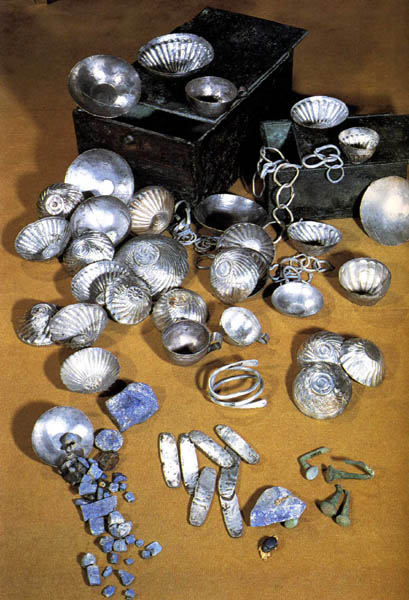 The
Tod
Treasure
The
Tod
Treasure
Discovered on 8 February 1936 by a French team led by Fernand Bisson de la Roque beneath a 5th-century AD mud-brick church, excavators came upon a temple of Senusret I. Here, in the stone foundations, had been concealed the 'Tod Treasure'.
A cache of Saite (26th-Dynasty) bronze figures of Osiris had just been brought to light and then, deeper in the same foundation sand underlying the temple, four cast copper caskets. These, to judge from the large copper nails sprinkled around, had originally been contained in caskets of wood which had rotted away. The four caskets were cleaned and found to be of two sizes: 18 in and 12 in in length.
The two larger coffers were packed with lapis lazuli in both raw and worked states. The smaller with ingots and other items of gold (6.98 kg in total) and intact and crushed silver vessels, silver ingots and other items (weighing 8.87 kg in total). Interestingly, the best pieces - those in a worked state or those which were intact - had in antiquity been placed carefully on the top, so that they would be seen first when the coffers were opened.
The boxes lids and front end-panels have cartouche containing the names and titles of Amenemhat II of the 12th Dynasty identifying, so the archaeologists assumed, the king by whom the treasure had been deposited, perhaps in his father Senusret I's memory. Here before them, evidently, lay a unique deposit of foreign tribute - hailing from as far way as Afghanistan in the east (source of the lapis lazuli) and the Mediterranean world to the west (apparent origin of the silver vessels).
The treasure was divided between Cairo and the Louvre. Because of its early dating and the fact that for several of the pieces contained in the treasure exceptionally close Minoan parallels can be cited. In a study by Barry Kemp and Robert Merrillees, however, it is suggested that the collection is stylistically later than the Middle Kingdom, and that the cache was found not in a sealed, 12th Dynasty context but in a substantially later phase of the temple construction employing antiquated containers.
Sources:
Ian Shaw and Paul Nicholson, The British Museum Dictionary of Ancient Egypt, The British Museum Press
Steven Snape, Egyptian Temples, Shire Egyptology
Richard H Wilkinson, The complete Temples of Ancient Egypt, Thames & Hudson
Dieter Arnold, The Encyclopaedia of Ancient Egyptian Architecture, I. B. Taurus
Nicholas Reeves, Ancient Egypt The Great Discoveries, Thames & Hudson